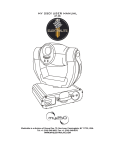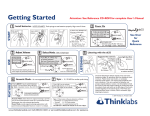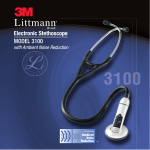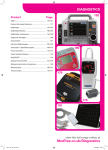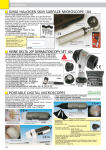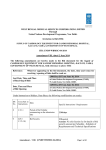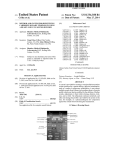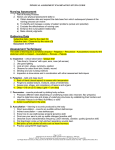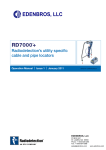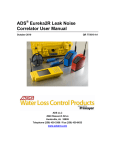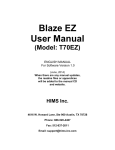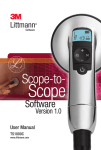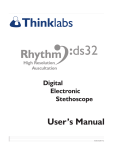Download User Manual - SensiCardiac
Transcript
User Manual SNSS2-‐50-‐UMAN-‐003.docx Page 1 of 34 All names and diagnoses depicted in examples herein are fictitious. No association with real persons is intended. Complying with all applicable copyright laws is the responsibility of the user. No part of this document may be reproduced or transmitted in any form or by any means, or for any purpose, without the express written permission of Diacoustic Medical Devices (Pty) Ltd. Diacoustic may have patents, patent applications, trademarks, copyrights, or other intellectual property (IP) rights covering subject matter in this document. The use of this document does not give anyone license to these patents, trademarks, copyrights, or other intellectual property. Caution: Federal law restricts this device to be sold by or on the order of a physician. SNSS2-‐50-‐UMAN-‐003.docx Project Confidential Page 2 of 34 Table of Contents 1 General Information.................................................................... 5 1.1 Indications for Use ......................................................................... 5 1.2 SensiCardiac Models ....................................................................... 5 1.3 Contra-Indications for Use ............................................................... 6 1.4 Precautions & Warnings .................................................................. 6 1.4.1 SensiCardiac General Warnings .................................................. 6 1.4.2 SensiCardiac Precautions ........................................................... 7 1.4.3 System Requirements ............................................................... 8 1.4.4 Required Accessories ................................................................ 8 1.4.5 Privacy Statement .................................................................... 8 1.4.6 Licensing Agreement ................................................................ 9 2 Getting Started ......................................................................... 10 2.1 Installing SensiCardiac................................................................... 10 2.2 Stethoscope Set-up ....................................................................... 10 2.2.1 SensiCardiac with Littmann 3200 ............................................... 10 2.3 Become a SensiCardiac User........................................................... 10 2.4 Log into SensiCardiac .................................................................... 10 2.5 Stethoscope Set-up ....................................................................... 12 2.5.1 Pairing Your Littmann 3200 ...................................................... 12 3 Use Instructions ........................................................................ 15 3.1 Icons, Buttons and Controls............................................................ 15 4 The auscultation sequence wizard ................................................ 18 4.1 Start Auscultation ......................................................................... 18 4.2 Enter the patient information .......................................................... 19 SNSS2-‐50-‐UMAN-‐003.docx Page 3 of 34 4.2.1 Record @ Aortic Position .......................................................... 20 4.2.2 Select the heart rate ................................................................ 21 4.2.3 Record the remaining heart segments ........................................ 22 4.2.4 Patient Findings ...................................................................... 23 4.3 Interpretation of Findings ............................................................... 23 4.3.1 Class I vs Class III findings ....................................................... 23 4.3.2 Murmur Location ..................................................................... 24 5 Panels and Forms ...................................................................... 26 5.1 SensiCardiac > About .................................................................... 26 5.2 SensiCardiac > User Account .......................................................... 26 5.3 SensiCardiac > Legal Notice ........................................................... 26 5.4 Settings > Account Information ...................................................... 26 5.5 Settings > Audio Devices ............................................................... 26 6 Troubleshooting ........................................................................ 27 6.1 Installation................................................................................... 27 6.2 Sound Recordings ......................................................................... 27 6.3 Sound Playback ............................................................................ 28 6.4 Error Messages ............................................................................. 28 6.5 Bluetooth Communication Error Messages ........................................ 31 6.6 Warning Messages ........................................................................ 32 7 Warranty Information ................................................................ 33 SNSS2-‐50-‐UMAN-‐003.docx Project Confidential Page 4 of 34 1 General Information 1.1 Indications for Use SensiCardiac is an electronic auscultation device, intended to provide support to the physician in the evaluation of heart sounds in patients. The product will acquire and record the acoustic signals of the heart and analyze these signals. The analysis procedure will identify specific heart sounds that may be present. Identified sounds include S1, S2, and suspected murmurs. The device is indicated for use in a clinical setting, by a physician or trained personnel who are acting on the orders of a licensed physician. It is not intended for use as the sole means of diagnosis. The interpretations of heart sounds offered by the SensiCardiac are only significant when used in conjunction with physician over-read, as well as consideration of all other relevant patient data. NOTE • The device is not intended to be the sole means of diagnosis. • Final judgment on the diagnosis still lies with the qualified medical personnel. • The medical history and physical examination results must be taken into consideration during the decision-making process. • The software is intended for use in a quiet environment on patients with an audible heart sound. 1.2 SensiCardiac Models SensiCardiac with Littmann 3200 SensiCardiac software is optimized to work with the Littmann 3200 electronic stethoscope. Consult the user manual of this stethoscope for optimal performance. SNSS2-‐50-‐UMAN-‐003.docx Page 5 of 34 1.3 Contra-‐Indications for Use SensiCardiac is not a diagnostic tool but an aid for the physician in making a diagnosis while taking into account the whole medical history of the patient. SensiCardiac is not to be used in a noisy environment. Care should be taken that no external noise could influence the sound recording of the electronic stethoscope. SensiCardiac should not be used on patients where the physician has difficulty to auscultate with an electronic stethoscope, obese patients and patients with pulmonary noise. 1.4 Precautions & Warnings 1.4.1 SensiCardiac General Warnings A warning statement in this manual identifies a condition or practice, which if not corrected or discontinued immediately, could lead to patient injury, illness or death. These warnings pertain only to the SensiCardiac software. WARNING: The information in this manual is a comprehensive guide to the operation of SensiCardiac. For best results, read this manual thoroughly before using the device. WARNING: SensiCardiac is designed for medical clinician use. Only a trained clinician who knows how to auscultate should use this device. WARNING: SensiCardiac is not intended for use in environments that are not under the supervision of a health care practitioner.. WARNING: SensiCardiac is not intended for continuous monitoring and must not be used as such. Where continuous monitoring is required, the appropriate equipment must be used. WARNING: To ensure patient safety, use only accessories and supplies recommended for or supplied with SensiCardiac. SNSS2-‐50-‐UMAN-‐003.docx Project Confidential Page 6 of 34 WARNING: Do not use the SensiCardiac during magnetic resonance imaging (MRI) scanning. WARNING: Carefully route patient cabling to reduce the possibility of patient entanglement or strangulation. WARNING: This device captures and presents data reflecting a patient’s physiological condition. When reviewed by a trained physician or clinician, this data can be useful in determining a diagnosis. However, the data should not be used as the sole means for determining a patient’s diagnosis or prescribing treatment. 1.4.2 SensiCardiac Precautions A caution statement in this manual identifies a condition or practice, which if not corrected or discontinued immediately, could lead to equipment failure, equipment damage or data loss. These cautions pertain only to the SensiCardiac software. Caution: If the accuracy of any measurement is in question, check the patient’s vital sign(s) with an alternative method and then check to verify if the device is functioning properly. Caution: For proper patient electrical isolation, only use a computer isolated from the supply mains. Caution: Use only parts and accessories that are supplied with the device and available through a legal supplier. The use of accessories other than those specified may result in degraded performance or unsafe use of the software. Caution: Portable and mobile radio frequency (RF) communications equipment can affect the performance of the Bluetooth interface. SNSS2-‐50-‐UMAN-‐003.docx Page 7 of 34 1.4.3 System Requirements To run SensiCardiac your computer system must meet the following requirements: • Windows 7 or 8 (32/64 bit) • Minimum RAM: 1 GB (2 GB recommended) • Intel Pentium 4 compatible • 1024 x 768 graphics display or better • 40 Mb open hard drive space • Audio Interface: o Internal or external Bluetooth connection for the SensiCardiac with Littmann 3200 model. 1.4.4 Required Accessories Littmann 3200 Electronic Stethoscope For audibility of the heart sounds, use headphones of good quality with a frequency range from 20 Hz to at least 10 kHz or higher. 1.4.5 Privacy Statement The software is used to store personal clinical and medical information. The use, storage and disclosure of information submitted, created or stored for the application of this software, either electronically or otherwise, is subject to all international, national, state/provincial and local laws, practices and regulations that are applicable to you, in particular laws, practices and regulations relating to privacy, and data, including the use, storage, disclosure and transmission of individually identifiable information. You are responsible for familiarizing yourself with any such laws, practices and regulations and for making the necessary arrangements to implement appropriate security measures to control access to patient data submitted, created and stored in relation to the software. SNSS2-‐50-‐UMAN-‐003.docx Project Confidential Page 8 of 34 In view of the above, the software permits the disclosure or sharing of heart sound recordings without disclosing the patient’s identity and no personal information is embedded within the heart sound files. Accordingly, you hereby assume all risks, responsibilities and liabilities associated with the use, storage, disclosure and/or transmission of information in relation to the software and Diacoustic is hereby indemnified from any claims, losses or damages resulting from your actions or negligence in this regard. Please consult your institution's information technology (IT) department or computer technician to implement appropriate security measures to protect access to patient data created and stored using this software. 1.4.6 Licensing Agreement Installing this software on your computer for the first time allows you to use it for a 15-day evaluation period and makes you subject to our End User License Agreement. After payment for the software and registration on the website of SensiCardiac (www.sensicardiac.com) you will receive a unique activation code. This code is linked to the serial number and registration code of the software. You will be allowed to register the software on no more than three computers. For each computer you will have to apply for a new unique activation code. Diacoustic Medical Devices will not take responsibility for the misuse of this software package. SNSS2-‐50-‐UMAN-‐003.docx Page 9 of 34 2 Getting Started 2.1 Installing SensiCardiac Download the SensiCardiac installation software from the SensiCardiac website (www.sensicardiac.com) and run the installation file. If you do not agree with the licensing agreements, select the "I disagree option", exit the installation process. This version of SensiCardiac does require .Net 4.5 to operate. If it’s not installed on your computer, you will be directed to the appropriate installation files. Complete the installation of .Net 4.5 before proceeding with the installation of SensiCardiac. After installing these programs, your computer will be restarted and proceed with the installation process. In the event that the installation process does not proceed automatically, re-run the downloaded installation executable file. 2.2 Stethoscope Set-‐up 2.2.1 SensiCardiac with Littmann 3200 See the Littmann 3200 stethoscope user manual before using this stethoscope. For a reliable Bluetooth connection the Littmann 3200 and computer must not be separated by more than 1 meter (3 feet). 2.3 Become a SensiCardiac User Go to www.sensicardiac.com and register as a user. After successful login into your SensiCardiac user account, subscribe for one of the subscription packages. If you select the Free option, you will be able to use SensiCardiac for 1 month. 2.4 Log into SensiCardiac Within the SensiCardiac software, use the username and password you create on sensicardiac.com to login into the program. SNSS2-‐50-‐UMAN-‐003.docx Project Confidential Page 10 of 34 Figure 1: SensiCardiac PC login screen. If you are not a registered user, select register and follow the instructions. SNSS2-‐50-‐UMAN-‐003.docx Page 11 of 34 2.5 Stethoscope Set-‐up 2.5.1 Pairing Your Littmann 3200 Figure 2: The Littmann 3200 set-up window. The computer’s internal Bluetooth device or the external USB Bluetooth device shipped with the stethoscope could be used. For optimal connection results, the external Bluetooth device is recommended. These windows are only relevant for the SensiCardiac with Littmann 3200 software. After start-up, the Littmann 3200 Set-up screen will appear. If you have a new stethoscope and have not paired your computer with this stethoscope before, select the Pair button and follow the instructions displayed. • Press and release the M button on the stethoscope. • The stethoscope’s main menu will display. SNSS2-‐50-‐UMAN-‐003.docx Project Confidential Page 12 of 34 • Use the (-) button to scroll to the Pair option. • Select this option by pressing (M). • The LCD will display the paring status. • Select the Pair button as displayed in the figure below to proceed. • Enter the required Pin number within the Windows environment. Select Pair on the Littmann 3200 set-up window Scroll to Pair on the stethoscope Menu and select Enter the pairing code in the software window and proceed Figure 3: The Bluetooth pairing window. SNSS2-‐50-‐UMAN-‐003.docx Page 13 of 34 If the devices were paired before, select the stethoscope you want to connect to and press the Connect button: • Depress and release the (M) button. • Scroll with the (-) button to the Connect option. • Select Connect by pressing (M). • Select Connect within the window below. Figure 4: The Bluetooth connecting window. SNSS2-‐50-‐UMAN-‐003.docx Project Confidential Page 14 of 34 3 Use Instructions 3.1 Icons, Buttons and Controls Record & Re-record Button This button is selected to begin a recording at a selected location. It can only be activated after all the patient’s information has been completed and you have selected Continue. The Step 1: Record at Aortic window appears with the Record button. Apply all the recommendations stipulated and then select Record. The Record button in the wizard is not active when the Start Auscultation icon is selected. This button is selected to re-record at a selected location. Select the location on the image or within the patient explorer then select the Re-record button. For all new recordings, the Auscultation sequence wizard should be followed. Play Button When this button is selected the complete audio recording of the selected heart sound is played back. NOTE: Using the SensiCardiac with Littmann, playback is only possible through the Bluetooth stethoscope. Stop Button This button stops the recording or audio playback. It is only visible while playing back a signal or recording a new signal. Volume Control The volume of the heart sound can be controlled by means of the slide control. Minimum volume intensity is at the left and maximum volume on the right. If the volume is muted a red cross is indicated. Clicking on the red cross unmutes the audio for the SNSS2-‐50-‐UMAN-‐003.docx Page 15 of 34 selected device. Playback Speed Control Sets the speed at which the selected heart sound can be listened to. Full speed is the speed at which the original recording of the heart was done. At half speed the heart sound is slowed down to half the speed of the original recording. Amplification of Heart S1/S2 & Murmur Enables the amplification of different components of the heart sound. S1 and S2 sounds are made more audible by amplifying the lower frequency band in which the S1 and S2 sound components are found by ignoring the higher frequency bands. Similarly, murmur amplification increases the audibility of the higher frequency sounds where the murmurs are more audible and suppresses the S1 and S2 sound components. A tick will appear in the block of the component, should you wish to amplify. Figure 5: The recording, playback and amplification controls. SNSS2-‐50-‐UMAN-‐003.docx Project Confidential Page 16 of 34 Figure 6: The current Patient List All the patients created within SensiCardiac will be displayed in the “My Patients” list. The following functions are available: • A new patient could be created. Recordings could be performed at a later stage. • Existing patient information could be edited. • An existing patient could be deleted. Figure 7: The patient session history. All previous recording session will be displayed. By selecting a session, the session information will be loaded with the findings. A selected session could also be deleted. SNSS2-‐50-‐UMAN-‐003.docx Page 17 of 34 4 The auscultation sequence wizard The wizard bar contains all the steps to complete an auscultation sequence. The steps have to be done in sequence to be completed successfully. To start an auscultation sequence, select the Start tab. This could also be used to perform a new auscultation sequence for an existing patient. Figure 8: The auscultation quick links 4.1 Start Auscultation The following window will appear on selecting the Start Auscultation tab: Figure 9: The first form of the auscultation wizard. Select: SNSS2-‐50-‐UMAN-‐003.docx Project Confidential Page 18 of 34 • New patient and session if you want to perform the auscultation procedure on a new patient. • Add new session if you want to add an auscultation procedure to the current selected patient’s auscultation history. 4.2 Enter the patient information Figure 10: The patient information form. Complete the patient information form and select continue. The patient’s ID, Name and Birth date are compulsory. SNSS2-‐50-‐UMAN-‐003.docx Page 19 of 34 4.2.1 Record @ Aortic Position Figure 11: Recording window. Before selecting the recording button, verify that the heart sound is clearly audible and the patient calm. The recording duration should be selected to record at least 12 clear heart beats. When ready, press Record on the screen or “M” on the stethoscope. SNSS2-‐50-‐UMAN-‐003.docx Project Confidential Page 20 of 34 4.2.2 Select the heart rate Figure 12: The heart rate selection window. Verify the calculated heart rate. If the indicated heart rate is correct, select Accept, else select the appropriate heart rate range from the drop down menu: • Default: 50 – 90 bpm • Athlete: 40 – 60 bpm • General: 50 – 180 bpm • Specific: 90 – 120 bpm • High: 120 – 180 bpm If no correct heart rate could be calculated, or if you are not satisfied with the recording, you may re-record the heart sound by selecting ReRecord. Select Cancel if you want to exit/stop the session. SNSS2-‐50-‐UMAN-‐003.docx Page 21 of 34 4.2.3 Record the remaining heart segments Figure 13: The recording locations. Repeat the pervious two steps (Record and Heart Rate Approval) for each of the remaining heart sound locations: • Pulmonary • Tricuspid • Apex SNSS2-‐50-‐UMAN-‐003.docx Project Confidential Page 22 of 34 4.2.4 Patient Findings Figure 14: The patient findings window. The findings for all four heart sound recordings are shown within the final window. If all four recordings is indicated as green, no echo-cardiography referral is recommended (Class III). If any one of the recordings is indicated as amber, echo-cardiography is recommended (Class I). Select Download PDF if you want to save the findings to a PDF file. 4.3 Interpretation of Findings 4.3.1 Class I vs Class III findings The American Heart Association and American College of Cardiology (AHA/ACC) recommends echocardiography under the following conditions8 Class I SNSS2-‐50-‐UMAN-‐003.docx Page 23 of 34 1. Echocardiography is recommended for asymptomatic patients with diastolic murmurs, continuous murmurs, holosystolic murmurs, late systolic murmurs, murmurs associated with ejection clicks, or murmurs that radiate to the neck or back. 2. Echocardiography is recommended for patients with heart murmurs and symptoms ischemia/infarction, or signs syncope, of heart failure, thromboembolism, myocardial infective endocarditis, or other clinical evidence of structural heart disease. 3. Echocardiography is recommended for asymptomatic patients who have grade 3 or louder mid-peaking systolic murmurs. Class III 1. Echocardiography is not recommended for patients who have a grade 2 or softer mid-systolic murmur identified as innocent or functional by an experienced observer. 4.3.2 Murmur Location The average relative energy distribution within a heartbeat is shown by means of energy distribution bar chart for S1, early systole (ES), mid systole (MS), late systole (LS), S2, early diastole (ED), mid diastole (MD), late diastole (LD). Figure 15: Normal Heart Sound recorded at the pulmonary location. SNSS2-‐50-‐UMAN-‐003.docx Project Confidential Page 24 of 34 Figure 15 shows the relative energy distribution for a normal heart sound within the systole and diastole regions are relatively low, indicating the absence of a murmur. Figure 16: Pathological heart sound recorded at the tricuspid. Figure 16 shows the relative energy distribution for a pathological heart sound, indicating a systolic murmur. SNSS2-‐50-‐UMAN-‐003.docx Page 25 of 34 5 Panels and Forms 5.1 SensiCardiac > About The About form provides company and program version specific information. 5.2 SensiCardiac > User Account The User Account provides information about the registered user. To change this information the user must log into the SensiCardiac account on www.sensicardiac.com and edit the user information. 5.3 SensiCardiac > Legal Notice This provides the Patient Privacy and confidential information. 5.4 Settings > Account Information The Account Information form provides information about the user subscription and the number of recordings remaining in the package for the current month. 5.5 Settings > Audio Devices This form allows you to access the stethoscope pairing and connection settings. SNSS2-‐50-‐UMAN-‐003.docx Project Confidential Page 26 of 34 6 Troubleshooting 6.1 Installation See the "Getting Started" part of this manual for troubleshooting after installation or at start-up for the first time. 6.2 Sound Recordings Troubleshooting Action – No recording of heart – Open the sound properties and set the record settings sounds. for the audio device to default. – Heart sound not – Set the recording volume level to 100%. recorded. – Heart sound signal saturates maximum and minimum. – Set the recording sample rate and bit rate to 2 channels at 16bit, 44kHz(or 44100Hz). – SensiCardiac should be restarted, since changing the driver settings halts the program. For help changing these settings see http://support.microsoft.com/kb/935309. Re-installing SensiCardiac If you uninstall SensiCardiac after using it for the after evaluation period evaluation period and re-install SensiCardiac again, the expired. evaluation period will remain expired. Not enough beats detected. Not enough heartbeats were recorded due to the fact that the heart rate may be slow and the recording duration to0 short. Increase the recording duration. Program crash while setting Windows shows a warning that this might happen, sound properties within “Device in use”. No information is lost. Restart the Windows Vista & 7. application to resume. When a recording fails or 1. Check stethoscope volume setting. has an incorrect result. 2. Check line-In recording volume level. During recording the signal display should be visible as a heart sound with distinguishable beats. 3. Switch off all amplifications and ambient noise SNSS2-‐50-‐UMAN-‐003.docx Page 27 of 34 reduction filter, which alter the signal being recorded. 4. If the detected S1-S2 peaks are incorrect, selected the heart-rate range for the recording that best matches the patient heart rate. The diagnosis is dependent on correct S1-S2 locations. 5. Also make sure that stethoscope is held firmly but with light pressure to minimise finger friction noises. Table 1: List of possible sound recording troubles Notes: For a reliable Bluetooth connection the distance between the computer and Littmann 3200 must not be more than 1 meter (3 feet). 6.3 Sound Playback Troubleshooting Action The recorded heart sounds do not - In SensiCardiac Software select ‘Settings- play back properly. >Devices’ from menu. Select correct output device from list of audio output devices. Make sure your headphones are plugged in and volume correct, then click the Test button to make sure the hardware is correctly set-up. – Set the playback volume to 100%. Table 2: List of possible sound playback troubles NOTE: Heart sounds are best heard using an electronic stethoscope. If you intend to use speakers or headphones make sure the frequencies response of the device supports the very low frequencies at which heart sounds are audible (between 20-500Hz). 6.4 Error Messages Error Message SNSS2-‐50-‐UMAN-‐003.docx Reason & Action Project Confidential Page 28 of 34 Heart sound signal quality test failed. – Initial 3-second quality test failed. – Follow the recording instructions. – Re-record the heart sound. Less than 5 useful beats detected – The heart sound signal could not be analysed after beat filtering. correctly. – Follow the recording instructions. – Re-record the heart sound. Heart sound signal could not be analysed correctly. – The signal variations were too large. – If the heart rate is fast, reduce recording time. – Follow the recording instructions. – Re-record the heart sound. Signal length incorrect. – Follow the recording instructions. – Re-record the heart sound. Recording stopped. Please Rerecord the signal. – Verify that all cables are connected correctly. – Verify that the stethoscope is switched on. – Follow the recording instructions. – Re-record the heart sound. Stethoscope powered off or not Verify that the stethoscope is switched on and try connected. again. Please select a beat from the – You have selected the Repeat button to play a Heart Sound to repeat. single heartbeat continuously in a loop, but did not select a beat. – Select the heart sound beat you want to play within the heart sound window and press Repeat again. The database directory does not – The patient database directory does not exist exist. Please try again. within the user profile directory. – Make sure the current windows user profile is the SNSS2-‐50-‐UMAN-‐003.docx Page 29 of 34 same as the user that installed the software. – Restart the program and try again. – If the error persists, uninstall the software and re-install it. An error occurred while – A process or program on your computer prevents attempting to clean your access to the database file. database. Please try again. – Close all programs and restart the program. No recording is selected to – You've selected the option to export a single export. Please select a recording recording, but did not select a recording. and choose this option again. – Select the recording you want to export within the patient tree view and select the export option again. No patient is selected. Please – You've selected the option to export a patient’s select a patient to export the recordings, but did not select a specific patient. desired records. – Select the patient's data you want to export within the patient tree view and select the export option again. An error occurred while – Close all programs, restart SensiCardiac and try attempting to recover your again to recover your database. database. Please close all – Make sure you are selecting the correct back-up Windows Explorer directories that files. are open and try again. The file that you selected must – To import a heart sound the file must be in the have a zip file extension. correct format (a .zip file). – The file you want to import must have been exported or backed-up by a SensiCardiac program. Could not load or analyse – The sound file was deleted from the programs recording. Please go to database, but is still displayed within the patient File>Database>Clean to remove tree. the dead link from the list. – Select File>Database>Clean to remove the dead link from the list. SNSS2-‐50-‐UMAN-‐003.docx Project Confidential Page 30 of 34 Could not store recording. – The program was not able to store the current recording. – Restart the program and redo the recording. Table 3: List of possible error messages 6.5 Bluetooth Communication Error Messages Error Message Reason & Action No stethoscope is connected. You terminated the stethoscope connection steps You can review data and manage without successfully connecting to a valid patients, but won’t be able to stethoscope. record or listen to sounds. You will be able to access previous recorded patients’ data, but will not be able to record or playback heart sounds. Could not connect to sender Connecting via Bluetooth to the stethoscope was stethoscope. Make sure the not successful. Restart the SensiCardiac software stethoscope is waiting to be and try again. connected to and restart the application. The stethoscope is already connected. Select a different stethoscope. Stethoscope battery level is low. Replace the stethoscope battery. Could not find the computer's The Bluetooth device was not detected. Make sure Bluetooth antenna. Make sure it is plugged into the computer. the Bluetooth antenna is plugged in and Bluetooth is enabled. If computer’s internal Bluetooth device is used, verify that it is switched on. Busy connecting, please wait... This may take a few seconds, please wait. Please select a stethoscope. Select one of the stethoscopes listed. SNSS2-‐50-‐UMAN-‐003.docx Page 31 of 34 Another stethoscope is already Terminate or disconnect current connection before connected. attempting new connection. Table 4: List of possible Bluetooth communication error messages. 6.6 Warning Messages Warning Messages Reasons & Actions Heart sound probably not – The heart sound signal amplitude is detected as very audible, check connectors. soft. – If the heart sound is not audible re-record the signal. Heart sound distortion: – The heart sound signal amplitude is detected as very volume too loud. loud. – If the heart sound is clipped, re-record the signal. The software evaluation – You did not register your software or obtained a valid period has expired. You may product Product Key and Activation code. continue using the software with limited functionality. – You will not be able to perform any heart sound recordings. – Please visit www.sensicardiac.com and register as a user for more information. Select the recording location Select a recording location on the image of the patient on the chest before and continue. continuing. Recording button disabled – You did not register your software or obtained a valid for trial period on expiry. product Product Key and Activation code. – You will not be able to perform any heart sound recordings. – Please visit www.sensicardiac.com and register as a user for more information. UserManual.pdf failed to open. – The UserManual pdf file has been moved or deleted. – Search for UserManual.pdf on your PC. – Load the UserManual from the installation disc or, if SNSS2-‐50-‐UMAN-‐003.docx Project Confidential Page 32 of 34 unsuccessful, back-up all your recordings and re-install the software. Make sure you have a back- – By selecting the database recover option, your up of your current database. current database will be substituted by the backed-up After recovery the current database. database will be deleted permanently. – The current database will be permanently removed and replaced by the backed-up one. To start a heart recording please set the windows – Your audio settings are set to mono. – Connect the Audio Device to the PC. recording device microphone properties to stereo 2- – Open microphone recording device properties. channel 22050Hz and try – Select Advanced and set the default channels, sample again. rate and bit depth to 2 channel, 22050Hz, 16bi.t For help changing these settings see http://support.microsoft.com/kb/935309. Table 5: List of possible warning messages 7 Warranty Information Consult the End User License Agreement for warranty information. SNSS2-‐50-‐UMAN-‐003.docx Page 33 of 34 SensiCardiac is a decision support software package intended to assist medical examiners in cardiac assessments. The software will enable the medical examiner to make more accurate decisions on Class I and Class III cardiac murmurs by analyzing the acoustic heart signals captured with an electronic stethoscope. Increase your auscultation confidence and Ø Ø Ø Ø Detect suspected heart murmurs Record and display auscultation sounds Playback and review of previously recorded sounds Print auscultation findings for your recording Consult the User Manual before using the software Minimum system requirements: Microsoft Windows® 7 or 8 Diacoustic Medical Devices (Pty) Ltd. Octo Place A3, Electron Rd, Techno Park, Stellenbosch, 7600, South Africa T +27 (0)21 880 2223 www.sensicardiac.com © Diacoustic Medical Devices (Pty) Ltd. All rights reserved. SensiCardiac and Diacoustic are trademarks of Diacoustic Medical Devices (Pty) Ltd. Windows is a registered trademark of Microsoft. Littmann is a trademark of 3M. Bluetooth is a registered trademark of Bluetooth SIG. ThinkLabs is a trademark of ThinkLabs Inc. Caution: Federal law restricts this device to sale by or on the order of a physician. SNSS2-‐50-‐UMAN-‐003.docx Project Confidential Page 34 of 34


































